| Home | Rides | Reviews | Bikes | Gallery | Tech | Misc | Contact |
| What To Do At Water
Crossings (or when one fails) How to Cross a Stream on a Motorcycle. by Martin Hackworth Photos: Martin Hackworth, Dan Colvin |
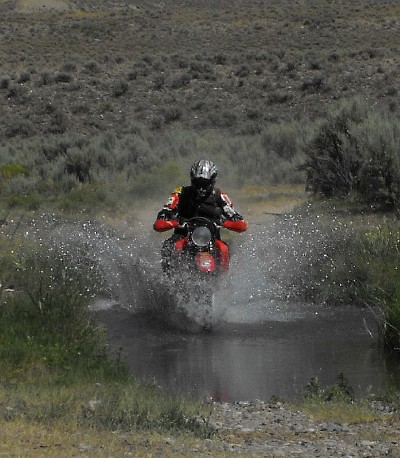
|
|
|
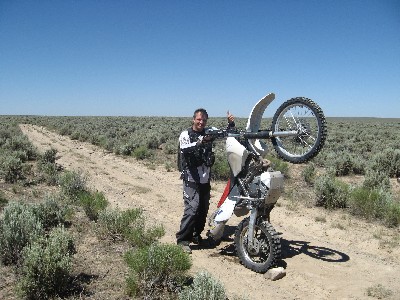 |
Water crossings are well-represented in the
anthology of tales shared among off-road riders. Always demanding of
attentio, and seldom dull, water crossings offer everything from a
brief respite from the heat to hypothermia. What follows
is a primer in how to successfully deal with water crossings and in
what do do
when you don't. We have many years of experience with all of this,
especially the latter. You are in good hands. The first thing to do when approaching water is size things up. This involves estimating how wide and how deep the water seems to be and it's rate of flow. Some of this can be amazingly difficult to judge from a moving bike. Because the rays of light that emanate from the bottom of a creek or stream bed bend down as they move from water into air, sighting back along those rays makes them appear to originate from a shallower depth. The further away you are, the easier it is to underestimate the depth of a water crossing. The innocuous-looking water crossing below, for instance, happens to be three feet deep. |
|
Unless
you
are certain that
a crossing is shallow and reasonably
clear of obstacles there is no shame in hopping off the bike and
taking a close
look before boldly
going where you have not gone before. Whitewater paddlers scout
rapids all of the time.
Your's is no disgrace. If, upon inspection, you determine that the water you want cross is any more than a bit deeper than your wheels are tall you might want to consider walking your bike across whatever you are trying to ford. If the water is deeper than your airbox you'll want do do this with the engine off. Motorcycles displace a fair amount of water when in deep and experience buoyancy equal to the weight of the displaced water. Pushing a bike across deep water, even with the engine off, does not require the effort that you might think - provided the water is not moving swiftly. For deep, swift water you should find another crossing. The consequences of sucking cold, highly incompressible water into a hot engine are at the very least time-consuming and unpleasant. At the very worst, the consequences are too awful to even consider. We hear that drowning isn't much fun either. |
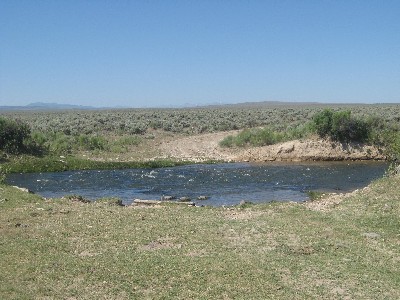 |
|
If you are familiar with the crossing, vision is good and it's a
straight
line just gas it and go. With enough speed we've seen people actually
skim impressive stretches of still water.
Though we are in no danger of pulling anything like that off
ourselves, it's quite possible. Don't try this with rapidly
flowing water though which has far less surface tension. Momentum is your friend when crossing water. As long as you don't need to change direction (at least very drastically) the more speed that you carry the harder it is for current, rocks, second thoughts, etc. to usurp your planned trajectory. For straight, shallow, clear crossings just stay on the gas and go. Sometimes you'll want to take it easy, especially when the water is murky or you don't know what to expect. Some creek crossings are littered with boulders and holes, and you'll want to pick your way through them more cautiously. Momentum is still your friend, but you'll want to carry a little less of it. Stream beds tend to be slick so don't stop if you don't have to. You might not be able to get going again from a dead stop in water, especially climbing out, without a push. |
|
Stand or sit? Generally we consider a water
crossing to be just like any other bit of technical terrain, which
means that the best position is up on the pegs and centered. But when
the water is murky, or we can see lots of rocks or rock steps,
sometimes we'll sit to make dabbing a foot on slick terrain a bit
easier. It's up to you. As much as any technical bit of wisdom, the key to a successful water crossing is confidence. Whatever strategy you decide to employ, pull the trigger and focus. Stay on the gas, stay in balance and use your momentum. If you are in somewhere in the middle of a water crossing and discover that it's deeper than you thought, you are going to have to make a quick decision. As tempting as it might be to gut it out for a few more feet, once the water starts to wash up around your seat, it's time to hit the kill switch. |
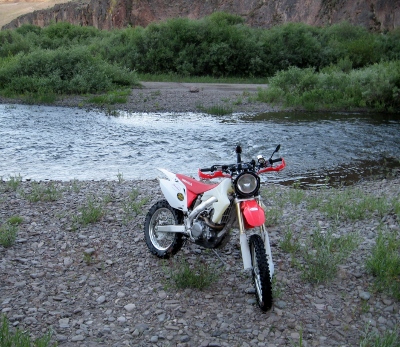 |
Not all water crossings are shallow at the edges
and deep
in the center. There may be holes anywhere in a stream bed, potentially
quite deep. Natural water crossings, like streams and rivers, are
almost deepest on the outside bend of any curve or meander. Still
water in an otherwise rolling flow may indicate either a
hole or
the deepest channel of the crossing (especially when it
occurs near one of the banks). We've been within just a few
feet
of a stream bank before when the bottom unexpectedly fell out. It
doesn't matter whether the water comes from near a bank or the center
of the stream - it locks up your engine all the same. It's better to
kill the engine than take a chance. If you cross enough water at some point you will dump your bike. In this event we cannot possibly emphasize enough the importance of hitting the kill switch before water gets past the air filter. If you kill the engine quickly enough, all you'll probably have to do is wring out and dry the air filter and then be on your way. But if you suck water into the engine you should hope that your surroundings are pleasant because you are going to be enjoying them for awhile. Water has several properties that make it ill-suited for being anywhere in your engine except the water jacket. Unlike everything else that gets drawn into the |
| cylinder
in
the normal course of events water is highly incompressible. This means
that when
a
cylinder inhales a dollop of water the piston rapidly stops moving and
the engine hydrolocks.
Stream
water is also much colder than everything else that
is supposed to
be in the engine and due to water's high heat
capacity it
tends to stay that way. This generally leads to enormous thermal stress. If your engine ingests water you are, at best, looking at spending much more time than you'd probably like draining it. At worst, you may discover a bent connecting rod, a warped head, a cracked block, ruined bearings or combinations of the above that render your engine inoperable. When you weigh the cost to benefits ratio of taking a chance, it's easy to see the wisdom of hitting the kill switch when things get deep. Sucking water into your engine at low revs, typical of a tip over in a stream, generally just locks it up. If this happens, assuming that there is no further mechanical damage, the consequences are just time and effort. You are going to have to get all of the water out of the cylinder, the fuel system, and the air filter before you can get going again. To resuscitate a drowned engine first remove the air filter. Wring it out and set it aside to dry. Shut off the gas, remove the spark plug from the engine and get the bike up on it's rear wheel to drain all of the water out of the exhaust. Next turn the bike over and drain water out of the cylinder through the spark plug hole. After doing this turn the bike back over and gently turn the engine over with the kick starter making sure that everything turns freely. If the engine spins easily without any bad sounds emanating from the crankcase or head you are probably OK. Leave the plug out and continue to spin the engine until you are sure that all of the water is gone. If your bike is carbureted remove the screw at the bottom of the float bowl and drain whatever is in there. Take off the top cap and either rotate the carb upside down or turn the entire bike upside down again to further drain it. Next open the fuel petcock, just enough to clear out any water that may have contaminated the gas line, then close it back. Unless the gas in the tank is contaminated (unlikely), this should take care of business. Fuel injected systems are generally sealed pretty well but you might want to disconnect a fuel line and crank the fuel pump just to make sure that nothing but gas is flowing thought the system. Put everything back together and turn the gently turn the engine over a few more times. By now your air filter should be dry (if, not wait until it is), replace it, turn the fuel back on and you are ready to attempt to start the bike in earnest. Hopefully you have a bike with electric start and a good battery. If you've done everything properly and the engine isn't damaged it should fire up with about the same difficulty as it does on a cold morning. If you have to kick start, especially a large displacement bike, good luck because you may be at it for a while. If there is a hill nearby you might consider a bump start. One time out in the middle of the Owyhee Desert we had to clip a strand of barbed wire from a nearby fence and tow a balky XR400R about three miles over rocky desert pediment, in gear, before it would start and run. When it finally started after miles of being towed it proved to be enough of a surprise to it's rider that he flat-out ran over the towing bike. We have never suffered any engine oil contamination as the result of dunking a bike but we have suffered contamination of the transmission and clutch oil in a bike with a split crankcase (water entered through the transmission vent). Milkshake! If this happens your clutch will slip and rattle. There is not much that you can do about this short of an oil change which you should perform as soon as possible. Be prepared for a gooey mess when you pull the clutch cover off for the cleanup. We recommend flushing the tranny with some inexpensive oil to remove all of the contamination. We also recommend changing the engine oil as soon as possible even if there is no obvious contamination. For bikes with split reservoirs change the engine oil at least once then flush the transmission side with some inexpensive oil and diesel fuel. Drain then fill the tranny side with inexpensive oil and take the bike out and run it until it gets hot. Drain the tranny oil again and replace with whatever you normally use. We have had to do this up to three times to completely remove all of the contaminants after a long ride out of somewhere with some water in the tranny side. That's about all the wisdom that we have to share about stream crossings. To summarize - any water crossing that is more than a foot deep and few yards wide should be treated with respect. There is nothing wrong with stopping to have a look before you go charging into any unfamiliar crossing. It is notoriously difficult to judge the depth of water when approaching it from the side. Swift water may carry you away if you aren't careful, and murky, still water may be quite deep. Almost everything in a creek or stream bed is slick. As high effort as pushing your bike across a stream might seem, it is, we assure you, much less so than reviving a drowned engine. You might want to make sure that you keep the location of your kill switch in mind as you are blasting through water. If you have any additional tricks that we should know about, or photos or video to share, please email us. |
| When things go bad. How To Retrieve Your Bike With Pulleys Tips for Riding in Sand, Snow and Mud Reader Forum |
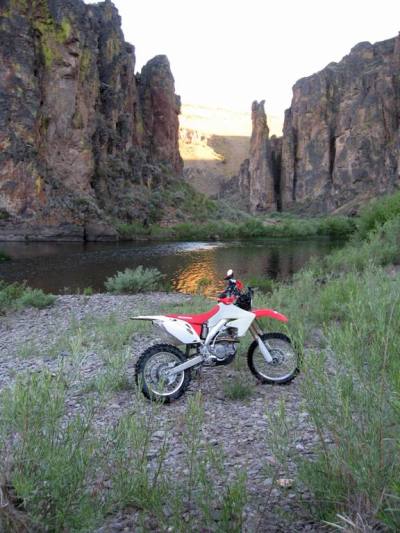 |
| Home | Rides | Reviews | Bikes | Gallery | Tech | Misc | Contact |
